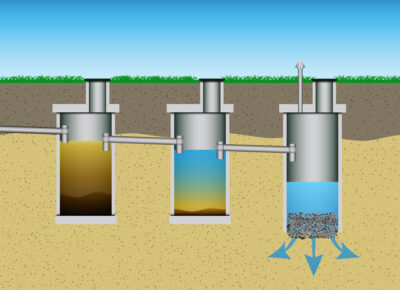Where should the sump pump discharge water be pumped to? After understanding how a sump pump functions with a French drain and the types of pumps, lastly where to pump the water is always the question. There are a few options, all with the same goal. The main purpose is to get the water as far from the basement as possible. The last thing a homeowner would want is the water to cycle right back down into the ground near the pump and continue this cycle. The water needs to be discharged as far from the basement as possible. With all properties having different characteristics there is not one perfect place for this to happen.
There are a few Sump Pump discharge options that typically make the most sense.
The first question always asked by homeowners is if I can pump that sump pump discharge water into the sanitary sewer. This is not the place to pump ground water with a sump pump. This would be a great way to get this water away from the home, except that it is not legal per NJ building codes and NJ State plumbing code. This will fail inspection by any township or inspector. The reason for not connecting sump pump discharge lines and ground water to the sanitary sewer is that the sewage carried by the sanitary sewer needs to go to the sewage treatment plant for treatment. This is a very costly system with a complicated pump system and treatment plant funded by tax dollars. Eventually after being treated, sewage will be sent back into our rivers and streams. The issue with adding sump pump discharge water (ground water) into the sanitary sewer is that ground water does not need to be treated. The government wants to treat the least amount of sewage possible to keep cost and taxes down. Sump pump discharge ground water does not need treated, but simply should be pumped away from a basement foundation.
The next question usually is about where should the sump pump discharge water be pumped to. There are a few good options for this. The most common option is out onto the yard. If the yard allows, this is great option. A small pipe leading the water to a reasonable distance away from the foundation is typically enough to make the system work effectively. If the proper soil is there, usually this does not cause problems.
Occasionally a yard will not be able to handle the additional water. If a yard is over saturated it could cause puddling. In this case at times a landscaper may need to design a water system for managing the water in the yard with underground piping. Often a underground drainage system is needed to direct water flow to where is needs to go. Some townships have storm drain systems and retention ponds capable of handling theses needs. Some neighborhoods and areas are able to have water directed to lower elevated areas with streams and run off directly from the yard. Depending upon what is provided to the neighborhood and living area, each home owner will have to decide what is best. These pump pump discharge lines may be directly connected to other drainage systems privately owned in the yard or in the neighborhood or community.
The last option would be to create a way to manage the water on the property. This would be a way to disperse the water on the property evenly. Often a seepage pit or dry well below grade can help with handling this sump pump discharge water. Often a large hole will need to be excavated with machinery. Piping will be needed to carry the water to a pit/dry well. This pit/dry well will help distribute water below the surface into the ground to avoid a wet unusable yard. This option can be costly, but effective.

